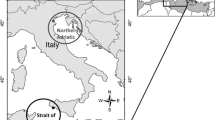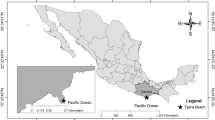Abstract
Scottolana canadensis is distributed widely along the east coast of North America. Although males exhibited mating behavior with females copepodites, copulation occurred following the female terminal molt. Crossing experiments revealed that in some cases, male mating behavior decreased with increasing latitudinal distance of male and female source locales. However, latitudinally-related differences in copepod body size most likely did not contribute to variation in male mating behavior. Survival patterns of fertilized eggs and fertility of offspring revealed postzygotic reproductive isolation of Florida populations from all others collected north to Maine.
Access this chapter
Tax calculation will be finalised at checkout
Purchases are for personal use only
Preview
Unable to display preview. Download preview PDF.
Similar content being viewed by others
References
Coull, B.C. 1972. Scotttolana canadensis (Willey, 1923 ) (Copepoda. Harpacticoida) redescribed from the United States East Coast. Crustaceana 22: 210–214.
Coull, B. C. & B W. Dudley. 1985 Dynamics of meiobenthic copepod populations: a long-term study (1973–1983). Mar. Ecol. Prog. Ser. 24: 219–229.
Guillard, R., 1975. Culture of phytoplanklon for feeding marine invertebrates. In W. L. Smith & M. H. Chanley (eds). Culture of marine invertebrate animals. Plenum. New York.: 29–60.
Haertel. L., C. Osterberg. H. Curl. Jr. & P. K Park. 1969 Nutrient and plankton ecology of the Columbia River estuary. Ecology 50: 962–978.
Lande, R., 1981. Models of speciation by sexual selection on polygenic traits Proc. natn. Acad. Sci. USA 78: 3721–3725.
Lonsdale. D. J., 1981a. Regulatory role of physical factors and predation for two Chesapeake Bay copepod species. Mar. Ecol. Prog. Ser. 5: 341–351.
Lonsdale. D. J., 1981b. Influence of age-specific mortality on the life history traits of two estuarine copepods. Mar. Ecol Prog. Ser. 5: 333–340.
Lonsdale. D. J. & J. S Levinton. 1985a Latitudinal differentiation in embryonic duration, egg size, and newborn survival in a harpacticoid copepod. Biol. Bull. 168: 419–431.
Lonsdale, D J. & J. S. Levinton, 1985b. Latitudinal differentiation in copepod growth: an adaptation to temperature. Ecology 66: 1397–1407.
Lonsdale. D.J. & J. S. Levinton. 1986 Growth rate and reproductive differences in a widespread estuarine harpacticoid copepod (Scottolana canadensis). Mar Biol. 91: 231–237.
Lonsdale, D.J. & J. S. Levinton. 1987. Energy budget differentiation among latitudinally separated Scottolana canadensis ( Copepoda: Harpacticoida ). (in review)
Lotka, A. J., 1925 Elements of physical biology. Williams and Wilkins. Baltimore.
Mantel, N., 1967. The detection of disease clustering and a generalized regression approach Cancer Res 27: 209–220.
Por, F. D., 1984. Canuellidae Lang (Harpacticoida, Poly-arthra) and the ancestry of the Copepods. Crustacean Suppl. 7. Studies on Copepoda II: 1–24
Smouse. P., E., J. C. Long, & R. R. Sokal. 1987 Multiple regression and correlation extensions of the Mantel test of matrix correspondance. Syst. Zool. 35: 627–631
Sokal. R. R., & F. J. Rohlf, 1981. Biometry. W. H. Freeman, San Francisco.
Templeton, A. R., 1981. Mechanisms of speciation-A population genetic approach Annu Rev. Ecol, Syst 12: 23–48
Willey, A.. 1923. Notes on the distribution of free-living Copepoda in Canadian Waters. Contr. can. Biol. (5). 1: 303–324.
Author information
Authors and Affiliations
Editor information
Rights and permissions
Copyright information
© 1988 Kluwer Academic Publishers
About this paper
Cite this paper
Lonsdale, D.J., Levinton, J.S., Rosen, S. (1988). Reproductive compatibility among latitudinally separated Scottolana canadensis (Willey) (Harpacticoida). In: Boxshall, G.A., Schminke, H.K. (eds) Biology of Copepods. Developments in Hydrobiology, vol 47. Springer, Dordrecht. https://doi.org/10.1007/978-94-009-3103-9_53
Download citation
DOI: https://doi.org/10.1007/978-94-009-3103-9_53
Publisher Name: Springer, Dordrecht
Print ISBN: 978-94-010-7895-5
Online ISBN: 978-94-009-3103-9
eBook Packages: Springer Book Archive




